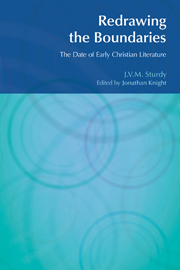Book contents
- Frontmatter
- Contents
- Preface
- Abbreviations
- 1 The Problem Posed
- 2 1 Clement
- 3 The Letters of Ignatius
- 4 Polycarp
- 5 Early Christian Literature: Some Parameters of Date
- 6 The Relationship of the Synoptic Gospels
- 7 Mark
- 8 Luke
- 9 Matthew
- 10 Acts
- 11 The Pauline Corpus: Its Growth and Development
- 12 The Catholic Epistles
- 13 Johannine Literature
- 14 Summary and Conclusions
- Appendix
- Notes
- Bibliography
- Index of Names
- Index of References
2 - 1 Clement
- Frontmatter
- Contents
- Preface
- Abbreviations
- 1 The Problem Posed
- 2 1 Clement
- 3 The Letters of Ignatius
- 4 Polycarp
- 5 Early Christian Literature: Some Parameters of Date
- 6 The Relationship of the Synoptic Gospels
- 7 Mark
- 8 Luke
- 9 Matthew
- 10 Acts
- 11 The Pauline Corpus: Its Growth and Development
- 12 The Catholic Epistles
- 13 Johannine Literature
- 14 Summary and Conclusions
- Appendix
- Notes
- Bibliography
- Index of Names
- Index of References
Summary
First of all, let us consider the date of 1 Clement. 1 Clement 1:1 (“because of the sudden and successive misfortunes and accidents we have encountered”) long used to point us to 96 CE. But these words do not obviously refer to persecution; and if they do suggest persecution, it takes us away from the time of Domitian because it is now widely accepted that there was no Domitianic persecution of the Christians in the last decade of the first century CE. Nor is there a bishop of Rome, secure in the episcopal lists, called Clement to keep us within a few years of 96. 1 Clement may therefore be quite a bit later than 96, so long as we remember that it is quoted by Polycarp.
So far as a proposed Domitianic persecution is concerned, the theory that Domitian persecuted the Christians towards the end of his reign has been very firmly criticized by L. L. Thompson and other scholars. There is a little evidence that Domitian harassed people of Jewish descent at this time, but no evidence at all that these Jews were Christians (see Dio Cassius 67.14.2). Nor did Domitian apparently promote the imperial cult with any more fervour than his predecessors and successors. This evidence casts doubt on the possibility that Revelation comes from the end of the first century if – as seems likely – the letter reflects an authentic experience of martyrdom.
The attribution of 1 Clement to Clement would e an approximate date c.96 CE if he were, as tradition says, a bishop of Rome who died about 104 CE.
- Type
- Chapter
- Information
- Redrawing the BoundariesThe Date of Early Christian Literature, pp. 4 - 7Publisher: Acumen PublishingPrint publication year: 2008



